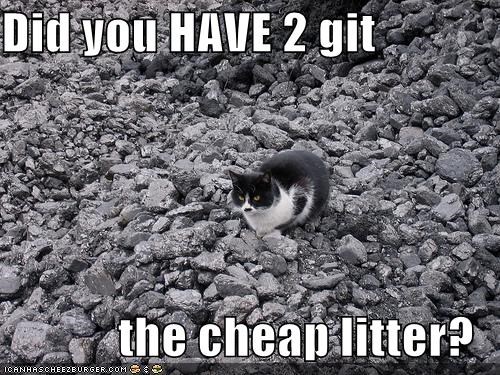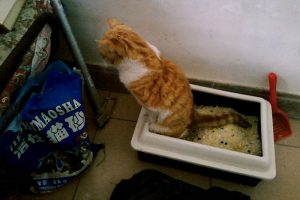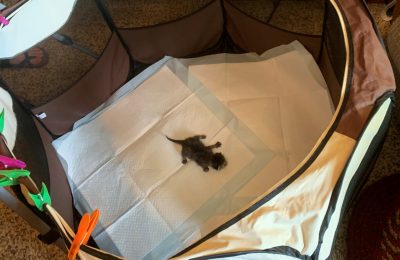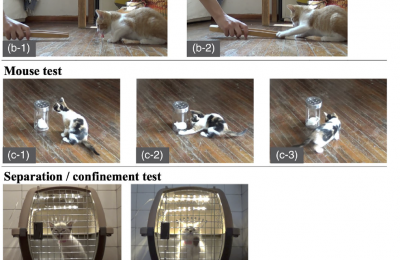A recent study helps us better understand cat elimination behavior
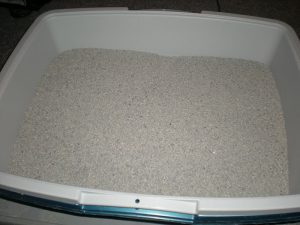
Going to the bathroom, it seems so simple – everybody does it! But when it comes to cats, things can get complicated. When we provide what they prefer in a litterbox, it’s like magic – you build it (the litterbox), they will come. Thanks to cats’ natural proclivities for eliminating in a loose substrate, we don’t even have to “train” cats to use the litterbox.
But when things go wrong, and by that, I mean pee on your bed or poop on the floor, they go horribly wrong. Nothing sends guardians into despair, and cats into homelessness quicker than a litterbox avoidance issue. Any research that can help us understand the intricacies of feline elimination behavior is a good thing in my book.
Recently the folks at Purina published a study in the journal Applied Animal Behavior Science called, “The ins and outs of the litter box: A detailed ethogram of cat elimination behavior in two contrasting environments.” This study was all about observation, no judgment, with a goal of providing a detailed ethogram of the behaviors that cats exhibit during elimination.
Twelve cats (six female, six male) who live in an enriched environment at the Purina cattery participated in the study. First the cats were allowed to acclimate to the testing room for 4 days. The testing room was 12 x 13’, with elevated resting areas, toys, and a large litterbox (approximately 3’x3’ square, and six inches high) with sandy clay clumping litter. On the 5th day, filming of the cats began, focusing on pre-, during, and post-elimination behaviors. On days 9 to 13, the cats were moved to a small enclosure (2 x 2.3 x 2.7’) within the room, to mimic the “clinical” environment a cat might be housed in while in a veterinary hospital or boarding facility. Cats were also given a smaller litterbox (16” x 12” x 4” high) and the litter was switched to polypropylene beads, similar to pellet litters that are sometimes used instead of the softer litters.
Ninety-one elimination events were recorded during the study, 58 urinations, 24 defecations, and nine 2-for-1s (or a number two with a number one!). From this, the researchers were able to come up with a detailed list of observations and differences between the two conditions (original vs clinical environment). Let’s take a closer look at some of the interesting findings!
First of all, 7 to 8 AM was the most popular time to pee and poop. In case you were wondering (of course, this might be related to what time the cats are fed, which was not noted in the manuscript).
From this study, 38 elimination behaviors were observed and included in an ethogram, which covers everything from tail positions to paw motions and body postures. From the observed behaviors, and what we know from studies previously published by Wailani Sung & Sharon Crowell-Davis, and by Nicole Cottam & Nicholas Dodman, we can assume that there were some things about the clinical setting that the cats didn’t like.
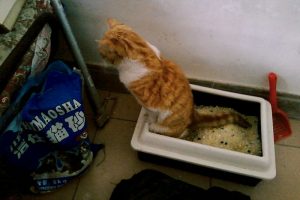
During urination, cats did more pawing at the litter when eliminating in the beads; they also did more “paw shifting” and kept fewer paws in the box with the beads. They also urinated less frequently and for longer periods in the clinical setting. When defecating, the cats were more likely to balance their paws on the side of the box, and were more hesitant to enter the box in the clinical setting with the bead litter.
For both urination and defecation, the cats spent more time sniffing their eliminations, and scratching at the walls or sides of the box in the clinical setting; there were no differences in time spent digging in the different litter substrates. The only times that the cats eliminated outside the box was in the clinical setting, with four urination and five defecation events occurring elsewhere.
Unfortunately, one issue with the current study is that in the “clinical” environment, the experimenters changed three things at once: the size of the enclosure, the size of the litterbox, AND the type of the litter. It’s hard to say for certain that the behavioral changes observed during the switch from enriched to clinical setting were due to one of those things, or perhaps because of an additive or interaction effect between more than one change. To tease factors like these apart, it’s really best to only change one thing at a time.
The authors suggest that a quick elimination experience may actually be a good thing; the extended time cats spent pawing at the areas around the box may have been because they kept smelling their waste in the box (also supported by more sniffing post-elimination in the clinical setting) – suggesting that the beads may not have provided enough odor control for the participating cats.
Another observation of concern was that the cats urinated less frequently and for longer periods in the clinical setting. This may be due to urine retention – in other words, that the cats were holding their urine for some reason (possibly because something about the litterbox experience was unpleasant). Urine retention can be a risk factor for urinary tract disease, which is another reason for us to better understand what helps cats love their litterboxes!
Perhaps most importantly, if we can assume that something about the clinical setting was distasteful to the cats, either the litter substrate, the size of the box, or both – this assumption further underscores the importance of understanding that USE does not equal preference. I’ve blogged about this before. Basically, just because your cat uses it, we should not assume they like it!
Because the cats showed some “frustration behaviors” in the clinical setting even when still using the box, including not putting all paws in the box and spending more time scratching at other areas besides the litter, the authors of the current study state, “out-of-box elimination alone may not provide a sufficient indicator of whether the cat finds the litter box experience acceptable.” Nuff said.
